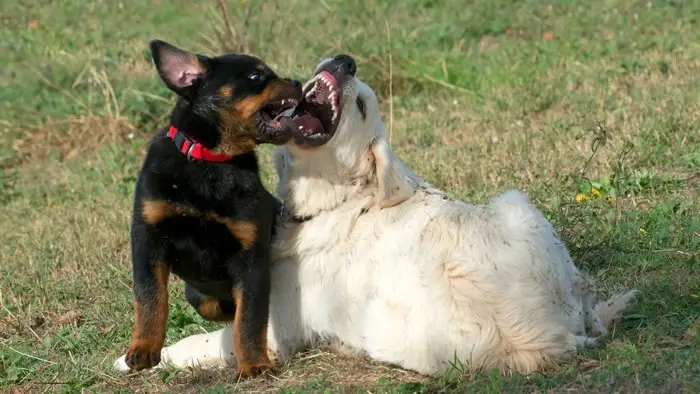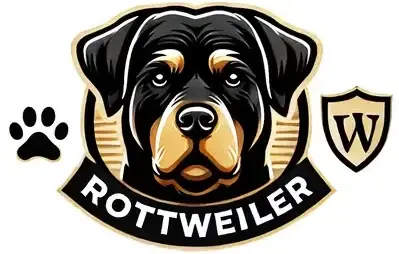Last Updated on July 12, 2021 by
Do you see any early signs of aggression in puppies you have at home? This attitude must be corrected to have peace in your family and in public!
Rottweilers are meant to be socialized because they have an aggressive tendency. Combined with their muscular stature and powerful bite, uncorrected behaviors should be mitigated as soon as possible. If an owner fails to train their Rottweiler puppy properly, they may have a problem in the future.
But when do you start this kind of training? If you are wondering “Why is my puppy biting me aggressively,” we might have the answers you seek.
Table of Contents
How Bad Is Aggression In Rottweilers?
In a DogsBite.org study conducted in 2019, Rottweilers ranked 3rd at 8% of fatal dog attacks in the United States. They rank third only to pit bulls and mixed breeds. These statistics have made them liabilities in some insurance contracts. Rottweilers are considered risky animals if they are not properly trained.
Rottweilers have also been found to be especially aggressive towards strangers. While this makes them capable guard dogs, it could lead to some disastrous accidents, especially with children. This natural tendency can be a future liability that can land you, the owner, in hot water.
Why Do Dogs Become Aggressive?
Puppy aggression in Rottweilers can manifest for a number of reasons. Like humans, some dogs also experience depression and trauma. If you are not the puppy’s first owner, it might be a sign that they experienced abuse or terrible living conditions in their first home.
They also could not have been socialized at a young age. Their aggression might act up in place of their fear and stress when not knowing how to deal with strangers. They are moved to show that they are dominant.
In any case, it’s important to recognize and address these signs of aggression.
Early Signs Of Aggression In Puppies
What are the aggressive puppy signs and how do you differentiate them from play? In puppy play, your dog should be playful and open. You will see them wag their tail, have their ears up, and keep their mouth open. Their barks should be high-pitched. Puppy play will be in a relaxed mood, and you will be able to feel this vibe throughout the session.
However, you might see the following behaviors, as well as your dog showing signs of tension and rigidity.
Biting and Holding
There’s puppy play biting, and then there is aggressive biting. You might also note that when the puppies bite, they don’t let go! This is potentially dangerous behavior and the habit needs to be nipped in the bud.
Biting onto toys and clothes is normal for playing or getting attention. When your puppy bites people or the other puppies in its litter, you need to watch closely. Bites that leave marks and draw blood are also too aggressive for regular play.

Read more about: Rottweiler Chihuahua Mix Full Grown: A Perfect Match?
Growling, Baring Teeth, and Snarling
This is one of the easiest to spot hallmarks of puppy aggression. Low, guttural growling is meant as a threat. When your puppy starts growling at you, there is something strange going on.
The combination of growling and baring teeth is called snarling, and this is when you know your dog means business. Being on the receiving end of this action is never fun!
Lunging Or Charging With No Contact
Aggressive dogs attack people or other animals unprovoked. Attacking children and people that they do not know, lashing out, and snapping without being touched is not normal behavior, even for brave and adventurous dogs.
Possessiveness and Jealousy
We wanted to have our food and toys to ourselves when we were young. But when you observe your dog becoming aggressive towards anyone who approaches their food or toys, it may be a sign of future aggression. It points to some sort of insecurity and confusion
Training For Early Signs Of Aggression In Puppies
Socialization For Early Signs Of Aggression In Puppies
It’s important to find the time to socialize with your Rottweiler puppies. This could be as easy as encouraging them to greet other dogs (and their humans!) wherever you go on your walks. You can then ramp this up by visiting the park. Exposing your dog to different dog breeds and types of people can help them ease up on their aggression towards strangers.
Bring them into play dates with puppies of different ages and breeds. Learning to behave properly among strangers (dogs and humans alike) will be beneficial for future training and relationships.
Treat every positive experience as an accomplishment. Reward your dog for being friendly, kind, and open when you are out exploring.
Obedience Training
Put your disciplinarian hat on and engage in some obedience training with your dog. You can opt to try out a training program formulated by reputable trainers. This will help you make sure that you are applying proper methods while training your puppy.
Set aside time when you are able to focus on training your dog. Stimulating their minds and bodies through fun obstacle courses and puzzles have a lot of benefits. They could improve patience and discipline in your puppy, and encourage more open behavior.
You should teach your dog basic commands and how to ignore other dogs and people. This might take a lot of your energy and effort, but a well-behaved dog is always worth it!
Positive Reinforcement
The positive reinforcement method is a good way of communicating to your dog the correct behaviors. In fact, punishing bad behaviors has the potential to worsen aggressive tendencies.
Rewarding good behavior with toys and treats will help your puppy understand your expectations. You should also be consistent with your rewarding system to help your dog understand which behaviors are desirable. If you are not consistent in your methods, your dog may become confused and carry on with its aggressive behavior.
When things become tough, it’s always best to consult with your Veterinarian and even contract a Professional Behavior Expert. This will be the proper way to address the aggression concerns for the safety of both your family and your dog.
Have you ever seen some early aggression warning signs in your dog? How did you address the situation? Let us know in the comments!
